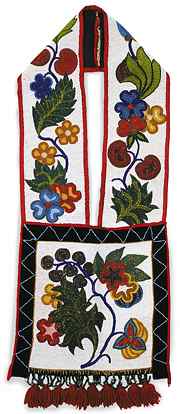 Tweed Museum of Art. (right:
Bandoiler Bag, Ca. 1930s (Ojibwe possibly WPA revival), Floral and
foliate beaded applique, spot-stitched, on fabric, zig-zag pattern on edges,
no pocket, 37 3/4 x 14 1/2 inches)
Tweed Museum of Art. (right:
Bandoiler Bag, Ca. 1930s (Ojibwe possibly WPA revival), Floral and
foliate beaded applique, spot-stitched, on fabric, zig-zag pattern on edges,
no pocket, 37 3/4 x 14 1/2 inches)Editor's note: The Tweed Museum of Art provided source material to Resource Library for the following article or essay. If you have questions or comments regarding the source material, please contact the Tweed Museum of Art directly through either this phone number or web address:
Selections from The Richard E. and Dorothy Rawlings Nelson Collection of American Indian Art
September 30, 2008 - September 13, 2009
Selections from
The Richard E. and Dorothy Rawlings Nelson Collection of American Indian
Art opened to the public on September 30, 2008
at the  Tweed Museum of Art. (right:
Bandoiler Bag, Ca. 1930s (Ojibwe possibly WPA revival), Floral and
foliate beaded applique, spot-stitched, on fabric, zig-zag pattern on edges,
no pocket, 37 3/4 x 14 1/2 inches)
Tweed Museum of Art. (right:
Bandoiler Bag, Ca. 1930s (Ojibwe possibly WPA revival), Floral and
foliate beaded applique, spot-stitched, on fabric, zig-zag pattern on edges,
no pocket, 37 3/4 x 14 1/2 inches)
The Tweed Museum of Art and the University of Minnesota Duluth recently received a major gift of over 400 American Indian artifacts and artworks, and an extensive research library, from the collection of Richard E. and the late Dorothy Rawlings Nelson of Duluth. The gift of the Richard E. and Dorothy Rawlings Nelson Collection is equal in importance to the original Tweed gift which established the museum in 1950, and the 1988 Sax Brothers gift which provided an acquisitions fund and a museum addition. A retired Presbyterian Minister, Richard Nelson was born in Marquette, Michigan, and was a pastor in churches in the Midwest, and on campuses in Iowa, Kentucky, and Minnesota, including UMD and the University of Wisconsin-Superior. He and his wife, the late Dorothy Rawlings Nelson, lived most of their married life on the shores of Lake Superior in Michigan and Duluth.
"We purchased our first Native American art in the early 1950s at Sault Ste. Marie, Michigan -- a small porcupine quilled container of birchbark. Little did we realize that as the decades passed it would be joined by dozens of additional pieces, or that our interests would expand. It seemed natural that the materials used to form items in the collection would come from the birch, ash, spruce, cedar and basswood trees, grasses and animals in the area. From containers and basketry, the collection grew to include the distinctive floral beadwork seen on bandolier bags, moccasins and other beadwork of the region." - Richard Nelson, "The Collector's Eye," in Shared Passion, Tweed Museum of Art, 2001.
In the 1980's the Nelsons also began collecting the work of contemporary American Indian artists, establishing in their collection a continuum of American Indian cultural life in the Great Lakes region, from 16th century maps, Ojibwe, Iroquois, and Cree artifacts from the 1850s to the 1940s, up to contemporary works by the major American artists George Morrison, Patrick DesJarlait, David Bradley and Frank Big Bear.
Selected portions of the collection of Richard E. and Dorothy Rawlings Nelson have been exhibited throughout the United States. In 2001 the Tweed Museum of Art created a document of the collection in the exhibition and book Shared Passion: The Richard E. and Dorothy Rawlings Nelson Collection of American Indian Art.
"This gift of Ojibwe and Eastern Woodlands artifacts, along with its associated maps, historical documents, and research library was carefully assembled over a forty year period by a dedicated couple who took on the task of collecting and researching the American Indian Art of this region. Because of their generosity and foresight, the Tweed Museum of Art, the University of Minnesota Duluth, its American Indian Studies programs, and the entire region will have a significant visual record and archive from which to enjoy and learn," says Peter Spooner, the museum's Curator.
Recognizing the significance of the Nelson gift, the Tweed
Museum's Board of Advisors took a lead role in raising funds for a new display
system showcasing the Nelson Collection. A fifty foot floor to ceiling
glass case on the second-level balcony of the Tweed was designed by architect
Jon Helstrom, specifically for the art and artifacts of the Nelson Collection.
The museum's staff worked with a group of American Indian advisors to create
the display's content, design and educational information for the opening
in September of 2008.
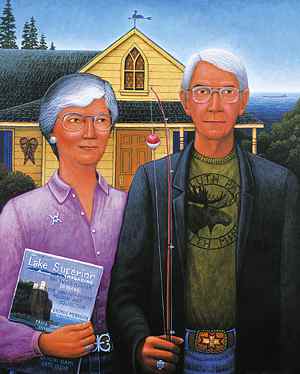
(above: David P. Bradley, American Gothic: Dorothy and Richard Nelson on the Shores of Gitchi Gami, 2000, Acrylic on canvas , 30 x 24 inches)
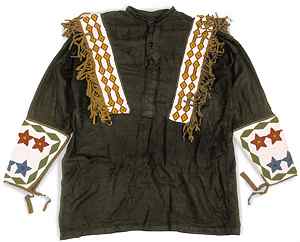
(above: Beaded Shirt, Ca. 1920s (Ojibwe, Nett Lake Reservation, MN). Green Fabric shirt with loom beaded otter tail design on shoulder strips and fully beaded gauntlet-like cuffs; shoulder strips have loom beadwork on leather, with with ad brown beads; cuffs are spot stitched with beaded star and diamond designs of white , red, yellow, green, light and dark blue beads. Shoulder strips: 3 inches wide x 32 inches long. Cuffs: 6 inches wide x 8 inches long. Overall with sleeves extended: 29 x 58 inches)
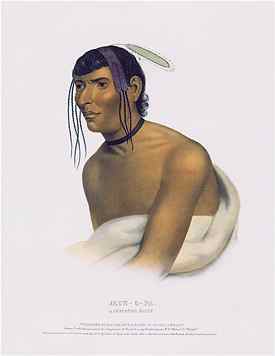
(above: Charles Bird King "Jack-O-Pa, A Chippeway Chief," Lithograph, hand-colored)
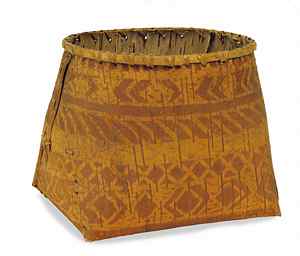
(above: Mokuck, Ca. 1890 (Ojibwe), Scratchwork in geometric pattern, same pattern all around. Birchbark with basswood ties, willow rim, 5 3/4 x 7 x 5 3/4 inches)
RL readers may also enjoy:
Read more articles and essays concerning this institutional source by visiting the sub-index page for the Tweed Museum of Art in Resource Library.
Search Resource Library for thousands of articles and essays on American art.
Copyright 2008 Traditional Fine Arts Organization, Inc., an Arizona nonprofit corporation. All rights reserved.